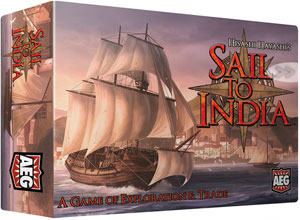



play board games
Board game reviews, strategy tips & session reports
Sail to India Game Review
 Stats:
Stats:
No. of players: 3-4
Amount of time to play: 45-60 min
Age requirements: 12+
Set-up time: minimal
Sail to India is a race game that requires good resource and component management to win. This micro-game has a small footprint but a good bit of strategy.
Sail to India Rules Description:
The board in Sail to India is made up of a line of cards. The first card is Lisboa. The next three cards are face-up. The last card represents India. You start in Lisboa and sail to India which is 9 to 12 cards away (depending on the number of players). You use your cubes to represent ships, buildings and goods and to mark your wealth and VPs. On your turn you get two actions and can even take the same action twice on your turn. The actions you may take are employ markers, moves ships, build buildings, sell goods, acquire technology or increase ship speed.
When you employ a marker you move it from the stock to Lisboa. This is the only way to have you cubes ready to mark your wealth or score or to turn into ships.
You may move all your ships with one move action and any ships that land below a card with free good spaces may be placed on the card and turned into those goods. Once per turn you can also explore a face-down card. This gets you 1 VP (or 2 VP if it is the last card in the line).
For two wealth you may turn a ship into a build a building if it is not already occupied. There are three types of buildings, churches, markets and strongholds. Churches are worth 2 VPs and markets and strongholds are worth 1 VP at the end of the game. Markets also provide you with one type of good and strongholds let you move ships from them instead of Lisboa.
Selling goods gets you wealth and if you sell enough you also get VPs. There are six types of goods and the more types you have the more wealth and VPs you earn. Cubes used to mark your good s go back to Lisboa after being sold.
There are several technologies in the game and you start with three scientists. When you acquire technology, you move a scientist cube to an unoccupied technology and pay its cost in wealth.
Everyone starts with a ship speed of one. You can pay to upgrade your speed and move two or three cards at a time.
Once someone reaches India the other players get one last turn. The game can also end once two players have no cubes left in the stock. Then you tally your VPs and the player with the most wins.
Quick Review of Sail to India:
Sail to India is a fun, portable game that feels like a race. You need to get to India or time running out of cubes when you have enough of a lead to hold onto it.
The components for this game are great. The over-sized cards that make up the board are nice and easy to see. The art is nice and the rules are well-written. I like that the box is compact and is super portable.
The way the cubes flow around the board creates an interesting dynamic. Since you need cubes in Lisboa to track VPs and wealth, you need to carefully think when you sell goods or score VPs. One cube is needed for every five wealth or VPs. That also means the more you score and richer you are the less cubes you have for ships, goods and buildings.
The technologies are decent but the game moves pretty quick so if you don’t get them early you might not get your value from them. It also helps to get the ones you want early as only one player can have each technology. There are four 4-cost technologies that get you end game scoring. Three of them give you extra points for each building type. These can be useful and help guide your strategy.
I think Sail to India is better with four players instead of three. In the three player game you discard three random cards and so India is closer. Depending on the buildings on those cards you could really neuter someone’s strategy before the game even begins.
My group was also worried about the game’s replay value. There is some variety in the cards but with just three building types and six different goods, the board is always a bit different and a bit just the same.
If you are looking for a fun resource management game with a race element pick Sail to India up. It is easy to take and enjoy most anywhere.
Score and synopsis: (Click here for an explanation of these review categories.)
Strategy 4 out of 6
Luck 4 out of 6
Player Interaction 4 out of 6
Replay Value 3 out of 6
Complexity 3 out of 6
Fun 4 out of 6
Overall 4 out of 6


Leave a Reply